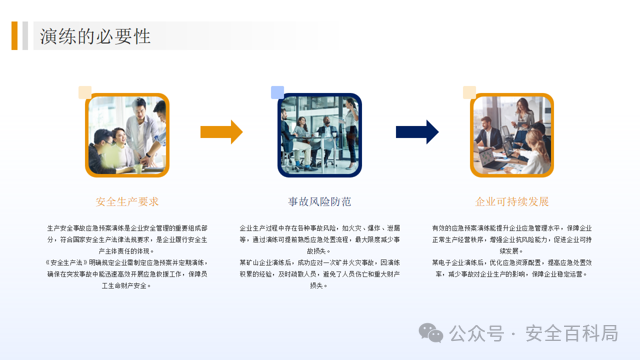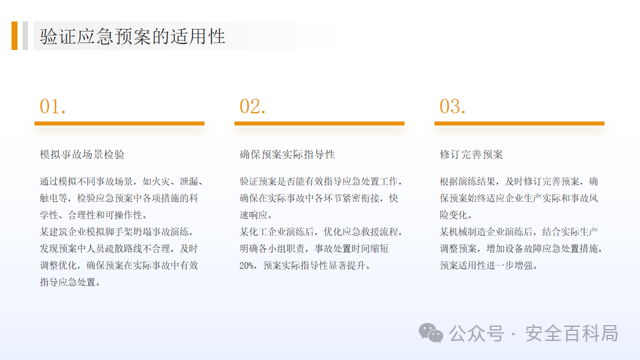IntroductionThe emergency response drill for production safety accidents is a crucial component of enterprise safety management. It is a key step in verifying the scientific, practical, and operable nature of emergency plans. Through drills, enterprises can effectively enhance their emergency response capabilities, improve their emergency management systems, and minimize accident losses. This article compiles common plans for emergency response drills for production safety accidents, covering objectives, preparations, implementation, evaluation, and summary, aiming to provide enterprises with a systematic and standardized reference template to enhance their safety production management capabilities.
1. Objectives of the Drill
(1) Verify the Applicability of Emergency Plans
By simulating accident scenarios, the scientific, rational, and operable nature of various measures in the emergency plan can be tested, ensuring that the plan can effectively guide emergency response work in actual accidents.
(2) Enhance Emergency Response Capability
Train the enterprise’s emergency rescue team in collaborative combat capabilities, improve employees’ emergency response speed and handling level during sudden accidents, and ensure that rescue work can be carried out quickly and orderly when an accident occurs.
(3) Improve the Emergency Management System
Through drills, identify deficiencies in the emergency plan and emergency management system, and make timely revisions and improvements to ensure continuous improvement and optimization of the emergency management system.
(4) Enhance Safety Awareness Among All Employees
Through drill activities, disseminate safety production knowledge, strengthen employees’ safety awareness and emergency avoidance capabilities, and create a good atmosphere for all employees to participate in safety management.
2. Principles of the Drill
(1) Scientific Principle
The drill plan should be based on the actual production environment and possible types of accidents, scientifically designing drill scenarios and processes to ensure that the drill is targeted and practical.
(2) Safety Principle
During the drill, ensure the safety of participants, equipment, and the environment, avoiding secondary accidents caused by the drill activities.
(3) Practicality Principle
The drill should closely resemble actual accident scenarios, simulating the real emergency response process to ensure that the drill results reflect the actual execution capability of the emergency plan.
(4) Full Participation Principle
The drill should involve management personnel at all levels, frontline employees, and relevant external units, ensuring that all personnel are familiar with the content of the emergency plan and emergency response processes.
3. Types of Drills
(1) Tabletop Drill
Conduct emergency response discussions in the form of tabletop exercises by simulating accident scenarios, focusing on testing the logic and operability of the emergency plan.
(2) Practical Drill
Conduct actual operational drills in simulated or real environments to test the collaborative combat capabilities of the emergency rescue team and the level of support for emergency supplies.
(3) Comprehensive Drill
Combine various types of accidents and emergency response processes to conduct cross-departmental and cross-unit comprehensive drills, fully enhancing the enterprise’s emergency management level.
4. Drill Preparation
(1) Establish a Drill Organization
Drill Commander: Responsible for the overall planning and command of the drill.
Drill Planning Team: Responsible for formulating the drill plan, designing drill scenarios, and writing drill scripts.
Drill Evaluation Team: Responsible for observing and evaluating the drill process, recording problems and improvement suggestions during the drill.
Drill Support Team: Responsible for coordinating and ensuring the materials, equipment, venues, and personnel for the drill.
Emergency Rescue Team: Responsible for emergency response work during simulated accidents, including rescue and medical assistance.
(2) Formulate the Drill Plan
Drill Objectives: Clarify the goals and expected outcomes of the drill.
Drill Type: Determine the form of the drill (tabletop drill, practical drill, or comprehensive drill).
Drill Time and Location: Specify the exact time, location, and range of participants for the drill.
Drill Scenario Design: Design reasonable accident scenarios based on the production characteristics of the enterprise and possible types of accidents.
Drill Process: Detail the planning for the initiation, implementation, evaluation, and summary of the drill.







Not completed, please follow for more…..
Click below to read the original text and download more materials